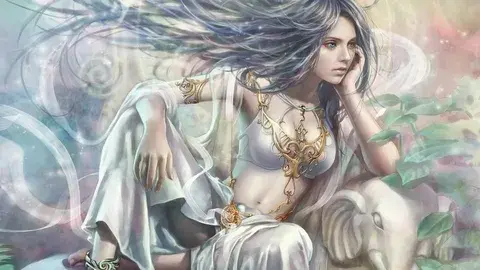When you hear the phrase “beautiful art women,” what comes to mind?
Is it the elegant strokes of a brush on canvas?
The powerful depiction of femininity in sculpture?
Or perhaps the captivating essence of women captured through photography?
Art has an incredible ability to resonate with our experiences, emotions, and ideals. And when it comes to women in art, there’s an entire world to explore.
In this article, we’ll dive into the myriad ways women are portrayed in art, the artists behind these beautiful creations, and how these representations can inspire us in our everyday lives.
Whether you’re an art enthusiast, a budding artist, or someone who appreciates beauty, this exploration is for you.
The Power of Representation in Art
Art isn’t just about aesthetics; it’s a reflection of society, culture, and identity.
When we talk about beautiful art women, we’re addressing how women are represented and perceived in various art forms.
From classical paintings to modern installations, women have been depicted in countless ways—each carrying its own message and meaning.
Historical Context
Historically, the representation of women in art has often been tied to societal norms and expectations.
- In classical art, women were frequently depicted as muses or symbols of virtue.
- During the Renaissance, artists like Botticelli and Raphael portrayed women with an idealized beauty, often emphasizing their physical attributes.
- In contrast, the 20th century saw a shift. Artists like Georgia O’Keeffe and Frida Kahlo embraced individuality, representing women as complex beings with rich inner lives.
Understanding this historical context allows us to appreciate the evolution of women’s representation in art.
Why Representation Matters
Representation matters because it shapes our understanding of ourselves and others.
- When women see themselves reflected in art, it validates their experiences and feelings.
- It challenges stereotypes and expands the narrative surrounding femininity.
- Beautiful art women can inspire young girls to embrace their identities and express themselves authentically.
Celebrating Women Artists
While many artworks depict women, it’s equally important to highlight the women who create these stunning pieces.
Female artists have made significant contributions to the art world, often overcoming barriers to share their unique perspectives.
Notable Women Artists
- Frida Kahlo: Known for her vibrant self-portraits, Kahlo explored themes of identity, pain, and empowerment. Her work is a celebration of her heritage and experiences, offering a glimpse into her life and emotions.
- Georgia O’Keeffe: Often called the “Mother of American Modernism,” O’Keeffe’s paintings of flowers, landscapes, and bones symbolize femininity and strength, reflecting her deep connection to nature.
- Yayoi Kusama: A contemporary artist known for her immersive installations and polka dots, Kusama’s work challenges perceptions of reality and explores themes of infinity and mental health.
These women, through their art, have not only captured beauty but also conveyed powerful messages about identity, mental health, and the human experience.
The Importance of Support
Supporting female artists is crucial.
- Buying their work
- Visiting galleries showcasing their art
- Engaging with their stories on social media
All these actions contribute to a more inclusive art world.
Beautiful Art Women in Various Mediums
Art isn’t confined to paint and canvas; it encompasses a variety of mediums. Each offers a unique lens through which we can view and appreciate beauty.
1. Painting
In painting, women have been celebrated for their grace, power, and complexity.
- Portraiture: Captures the essence of individual women, showcasing their emotions and stories.
- Abstract art: Offers an interpretation of femininity through color and form, challenging viewers to find their meaning.
2. Sculpture
Sculpture provides a three-dimensional perspective on women.
- Classical sculptures: Often idealize female forms, emphasizing beauty and elegance.
- Modern sculptures: Can challenge traditional notions, portraying women in powerful and dynamic poses.
3. Photography
Photography has the power to capture raw, unfiltered moments.
- Documentary photography: Tells stories of women’s lives, struggles, and triumphs.
- Fashion photography: Celebrates beauty and style, often pushing the boundaries of femininity.
4. Digital Art
With technology’s rise, digital art has exploded in popularity.
- Graphic design: Allows for innovative representations of women, merging art with technology.
- Animation: Brings characters to life, often showcasing strong female protagonists.
The Impact of Social Media on Beautiful Art Women
Social media has transformed how we consume and create art.
Platforms like Instagram and Pinterest have become essential for artists to showcase their work, particularly female artists.
Creating Community
Social media enables women to connect with each other, share their stories, and find inspiration.
- Engagement: Followers can interact with artists, providing feedback and support.
- Collaboration: Artists can team up for projects, exhibitions, or online events, amplifying their voices.
Accessibility of Art
The digital age has made art more accessible than ever.
- Online galleries: Allow anyone to view and appreciate art from around the world.
- Virtual exhibitions: Offer opportunities for artists to showcase their work without geographical limitations.
FAQs About Beautiful Art Women
1. What defines beautiful art women?
Beautiful art women are typically characterized by their portrayal in a way that celebrates their identity, strength, and complexity. This can manifest in various forms, from paintings and sculptures to photography and digital art.
2. Why is it important to support female artists?
Supporting female artists helps promote diversity in the art world and encourages a wider range of perspectives and narratives. It allows for a more inclusive representation of women and fosters a sense of community.
3. How can I find beautiful art women?
You can discover beautiful art women through online platforms, galleries, and museums. Following women artists on social media and attending local exhibitions can also provide insight into their work.
4. Are there specific art movements focused on women’s representation?
Yes, movements such as Feminist Art, Women’s Art Movement, and contemporary art collectives often focus on women’s experiences and representation in art.
5. How can I get involved in supporting women in art?
You can support women in art by purchasing their work, attending exhibitions, sharing their stories on social media, and advocating for equal representation in galleries and museums.
Conclusion
As we’ve explored the world of beautiful art women, it’s clear that art is a powerful medium for representation and expression.
Through the lens of history, contemporary practices, and the voices of women artists, we see that beauty in art transcends mere aesthetics.
It speaks to the essence of our experiences, our identities, and our stories.
So next time you encounter art depicting women, take a moment to reflect on what that representation means.
What stories are being told?
What emotions are being evoked?
In embracing beautiful art women, we celebrate not just the artwork itself but also the rich tapestry of experiences that it represents.
Let’s continue to support and uplift women in art, ensuring their voices are heard and their stories are celebrated.
Read More: SkinCareSensation

